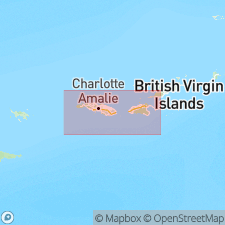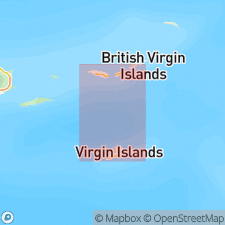
- Usage in publication:
-
- Louisenhoj Formation
- Modifications:
-
- Overview
- Revised
- Dominant lithology:
-
- Breccia
- Tuff
- Conglomerate
- AAPG geologic province:
-
- Caribbean region
Summary:
Louisenhoj Formation is lowest of Virgin Island Group. Named for excellent road cut exposures near Louisenhoj, just north of Charlotte Amalie, central VI. Occurs over most of St. Thomas and western half of St. John. Consists of augite andesite and varies between epiclastic and pyroclastic modes. Contains tuff and breccia. Cabes Point Conglomerate lithofacies occurs near base of formation in vicinity of Cruz Bay on St. John, and Cabes Point, Pearson Gardens, and Bunker Hill on St. Thomas. Conglomerate is interbedded with both pyroclastic and epiclastic rocks of the formation and consists of well-rounded keratophyre cobbles and pebbles derived from underlying Water Island Formation. Thickness ranges from 4,000 ft in eastern St. Thomas to 7,000 ft in western St. John with a possible maximum thickness of 13,000 ft. Lower contact with Water Island Formation marked in places by conglomerate overlying spilite or keratophyre; overlain by Outer Brass Limestone. Age is Late Cretaceous.
Source: GNU records (USGS DDS-6; Reston GNULEX).

- Usage in publication:
-
- Louisenhoj Formation*
- Modifications:
-
- Overview
- Geochronologic dating
- AAPG geologic province:
-
- Caribbean region
Summary:
Author follows usage of Donnelly (1959, 1966) for the rocks on St. Thomas and St. John, VI. They include (ascending) the Early Cretaceous Water Island Formation and the Late Cretaceous Louisenhoj Formation, Outer Brass Limestone, Tutu Formation (with its informal Coki Point Megabreccia lithofacies and Congo Cay Limestone Member of Donnelly, 1959), and Hans Lollik Formation. Five felsic rocks from Water Island Formation, dated by Michael Diggles (U.S. Geological Survey) using K-Ar whole rock techniques, yielded a range from 65.8+/-2.9 to 30.9+/-0.3 Ma. Two rocks from Louisenhoj Formation also were dated using K-Ar techniques by Diggles and yielded a range from 42.1+/-0.6 to 37.7+/-1.1 Ma.
Source: GNU records (USGS DDS-6; Reston GNULEX).
For more information, please contact Nancy Stamm, Geologic Names Committee Secretary.
Asterisk (*) indicates published by U.S. Geological Survey authors.
"No current usage" (†) implies that a name has been abandoned or has fallen into disuse. Former usage and, if known, replacement name given in parentheses ( ).
Slash (/) indicates name conflicts with nomenclatural guidelines (CSN, 1933; ACSN, 1961, 1970; NACSN, 1983, 2005, 2021). May be explained within brackets ([ ]).

